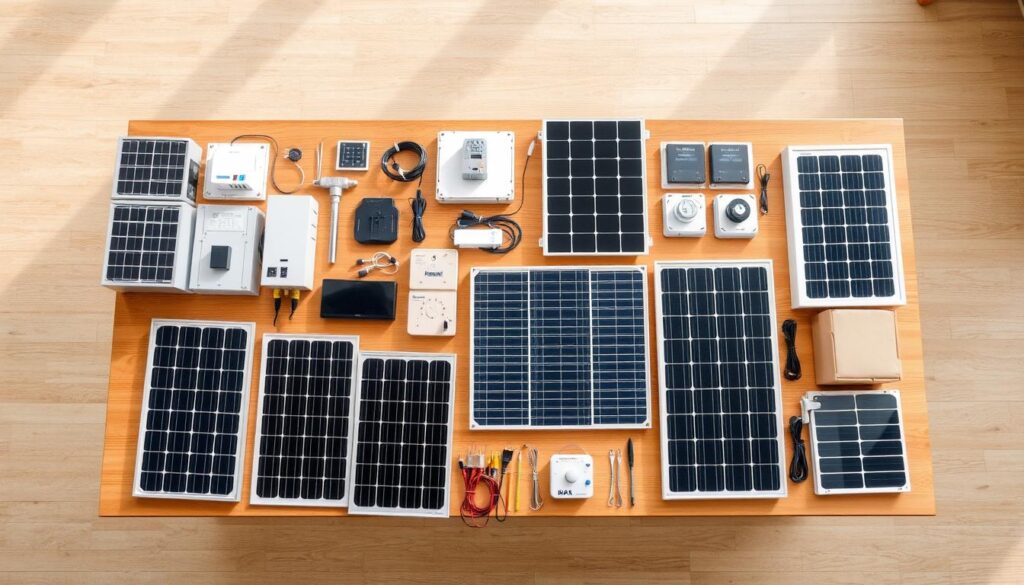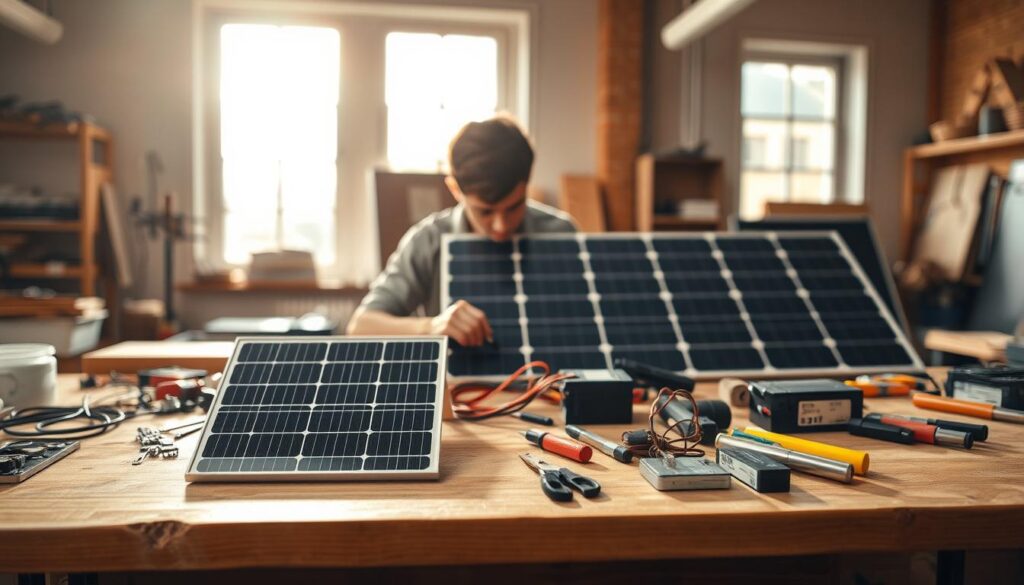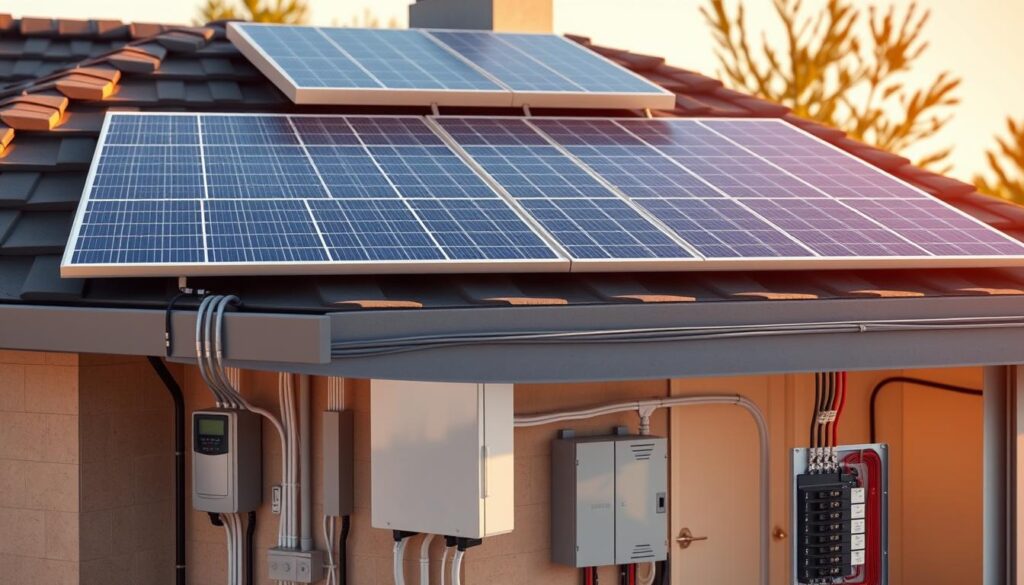Home solar panel kits are revolutionizing how households embrace renewable energy systems. From powering homes to reducing utility costs, these complete systems offer a path to energy independence. Brands like Unbound Solar and GoGreenSolar design tailored solutions, ensuring every kit includes components like inverters, batteries, and mounting hardware. With options ranging from grid-tied setups to off-grid systems, homeowners can choose a system that fits their unique needs.
Modern solar technology now makes it easier than ever to transition to clean energy. Companies like ZNshine, a Tier-1 manufacturer with over 35 years of experience, provide high-efficiency panels starting at affordable prices. Whether installing panels on roofs or grounds, these kits come ready with everything needed for a smooth setup, empowering families to take control of their energy future.
Key Takeaways
- Customizable systems fit diverse energy needs and installation spaces.
- Complete kits include all parts, from panels to mounting hardware.
- Options exist for homes, RVs, boats, and industrial uses through brands like Unbound Solar.
- Systems can be expanded as energy demands grow over time.
- Grid-tied systems let users earn credits by sending excess energy back to the grid.
Understanding Home Solar Panel Kits
Solar energy systems offer flexible options for homes, and choosing the right kit depends on your energy goals. Home solar panel kits simplify setup by bundling essential parts into ready-to install solutions. Let’s break down how these systems work and what they include.
What Are Solar Panel Kits?
Home solar panel kits are preconfigured packages containing all parts needed to generate solar power. These kits streamline installation by including panels, wiring, and mounting hardware. For instance, grid-tied kits from brands like Sunrun come with inverters and racking systems, while off-grid versions add battery storage. They’re designed for both small projects and full home setups, making solar energy accessible without starting from scratch.
Components of a Complete Kit
Every kit includes core items like solar panels and inverters. Additional parts vary, but common inclusions are:
- Solar panels to capture sunlight
- Inverters to convert DC to AC electricity
- Mounting hardware for secure installation
- Wiringing and connectors for safe energy transfer
Many manufacturers void warranties for installations not done by certified professionals. Always check requirements before DIY projects.
Grid-Tied vs. Off-Grid Systems
Grid-tied systems connect to local power grids, allowing homeowners to sell excess energy back through net metering. These are ideal for those staying grid-connected while lowering bills. Off-grid kits, meanwhile, rely on battery storage for full independence. Hybrid systems merge both, offering backup power during outages. Choosing between them depends on your energy needs and local utility policies.
Professional installers like Sunrun simplify grid-tied setups, ensuring compliance with NEC standards and maximizing efficiency. Off-grid setups often require more complex planning to meet daily energy demands.
The Environmental and Financial Benefits of Solar Power
| Benefit | Key Fact | Impact |
|---|---|---|
| Carbon Reduction | 3-5 tons CO2 reduced yearly | Cuts fossil fuel dependency |
| Financial Savings | $10k-$18k upfront cost, 10% ROI | Long-term cost reductions |
| Tax Incentives | 30% federal credit until 2033 | Lower upfront costs |
| Property Value | 17% higher resale price | Attracts buyers and boosts equity |
Reducing Your Carbon Footprint
Solar energy systems slash greenhouse gases. A typical 5kW system cuts 3-5 tons of CO2 yearly. Renewable energy systems like solar prevent pollution equal to planting 80+ trees annually. Over 4 million U.S. homes already reduce emissions through solar panels.
Long-Term Energy Savings
Switching to solar energy systems saves $100-$200 monthly. Over 20-30 years, homeowners save $20,000+ on energy. With a 10% ROI, systems pay for themselves in 5-15 years, depending on location. Many see savings exceed loan payments immediately.
Available Tax Incentives and Rebates
The federal Investment Tax Credit (ITC) offers 30% off system costs until 2033. After 2032, it drops to 26%. State rebates and utility programs add thousands more. For example, California offers up to $2,500 for solar installations.
Increasing Property Value
Homes with solar energy systems sell 20% faster and command 17% higher prices. A National Renewable Energy Lab study found solar panels add $15,000 to home value. Buyers prioritize homes with built-in savings and eco-friendly features.
Switching to solar energy systems saves $100-$200 monthly. Over 20-30 years, homeowners save $20,000+ on energy. With a 10% ROI, systems pay for themselves in 5-15 years, depending on location. Many see savings exceed loan payments immediately.
Available Tax Incentives and Rebates
The federal Investment Tax Credit (ITC) offers 30% off system costs until 2033. After 2032, it drops to 26%. State rebates and utility programs add thousands more. For example, California offers up to $2,500 for solar installations.
Increasing Property Value
Homes with solar energy systems sell 20% faster and command 17% higher prices. A National Renewable Energy Lab study found solar panels add $15,000 to home value. Buyers prioritize homes with built-in savings and eco-friendly features.
Homes with solar energy systems sell 20% faster and command 17% higher prices. A National Renewable Energy Lab study found solar panels add $15,000 to home value. Buyers prioritize homes with built-in savings and eco-friendly features.
With solar energy systems, homeowners gain cleaner energy and financial stability. Start calculating your savings with online tools like EnergySage or the U.S. Department of Energy’s Solar Calculator. Explore incentives at DSIRE.org for state-specific programs.
Types of Home Solar Panel Kits for Every Need
Home solar panel kits come in diverse configurations to match your energy goals. Grid-tied systems pair with utility lines to lower bills, while off-grid solar kits offer independence for remote locations. Hybrid systems blend both, storing energy in batteries. Let’s explore your options:
| Type | Use Case | Price Range | Energy Output |
|---|---|---|---|
| Grid-Tied | Urban/suburban homes | $2,000–$15,000 | 175–1,400 kWh/month |
| Off-Grid | Cabins, RVs, remote areas | $3,000–$10,000 | 200–550 kWh/month |
| Hybrid | Backup power + grid access | $5,000–$20,000 | 300–1,200 kWh/month |
| Specialized | Tiny homes, mobile setups | Varies | Customized |
For example, a 2kW grid-tied kit starts at $4,605 and produces 175–375 kWh/month. Off-grid kits like the 3kW system cost around $5,749. Hybrid setups, such as the 4kW ground mount kit, offer 350–750 kWh/month for $7,877. Prices rise with size—like the 8kW system at $12,703—but savings add up over time.

Choosing the right system depends on your lifestyle. Urban dwellers might prefer grid-tied kits for bill savings, while campers opt for portable off-grid solar kits. With federal incentives covering 26% of costs, now’s the time to explore your options.
How to Choose the Right Solar Energy Systems for Your Home
Choosing the right solar energy systems starts with understanding your home’s needs. Start by evaluating energy use, roof conditions, and budget to build a system that grows with your lifestyle.
Assessing Your Energy Requirements
Review utility bills to track monthly kilowatt-hour (kWh) usage. Multiply your average monthly kWh by 12 to find yearly demand. Seasonal changes matter: winter heating or summer cooling needs may require larger solar energy systems.
| Component | Function | Importance |
|---|---|---|
| Solar Panels | Convert sunlight to electricity | Essential for energy production |
| Grid-Tied Inverter | Converts DC to AC power | Necessary for home use |
| Mounting Hardware | Secure panels to roofs or ground | Ensure stability and safety |
| Monitoring System | Track energy output | Optimize performance |
Evaluatinging Your Roof’s Solar Potential
South-facing roofs with 30-degree angles work best. Use free tools like Google’s Project Sunroof to assess shading and sunlight hours. If your roof isn’t ideal, ground-mounted residential solar panels are a viable alternative.
Considering Your Budget and Financing Options
The average cost for solar energy systems ranges from $2.50 to $4.20 per watt. The federal tax credit offers 30% off installation costs (e.g., a $20,000 system saves $6,000). Enphase microinverters systems, which maintain 97% efficiency even if a panel is shaded, are a top choice for expandable setups.
- Check 25-year warranties on panels and inverters
- Compare loan rates with 30% tax credit savings
- Choose systems with modular designs for future expansion
GoGreenSolar offers free analysis to estimate your solar potential and budget. Prioritize systems that balance cost, efficiency, and growth potential to maximize savings long-term.
DIY Solar Panels: Is Self-Installation Right for You?
Going the DIY solar panels route can slash costs by 20–50%, but success depends on your skills. Let’s break down what’s needed to tackle this project confidently.

Skills and Tools Required
Basic electrical knowledge and comfort working at heights are must-haves. Essential tools include drills, torque wrenches, and voltage testers. A 20–40-hour time commitment is typical, though novices may take longer. Safety gear like gloves and safety glasses is non-negotiable.
Permits and Regulations
Obtaining permits varies by location. Check local building codes and utility interconnection rules. Many regions require inspections before activation. Missing permits could void warranties or lead to fines.
When to Hire a Professional
Complex roofs, systems over 10kW, or lack of electrical training signal the need for pros. Professionals ensure compliance with National Electrical Code (NEC) standards and handle tricky wiring. They also secure permits efficiently, saving time.
| DIY Solar Panels | Professional Installation |
|---|---|
| Cost savings up to 50% | Full warranty coverage |
| 20–40 hours of labor | Guaranteed code compliance |
| Risk of warranty voidance | Access to bulk equipment discounts |
Remember: solar panel installation mishaps risk safety and efficiency. If unsure, consult a certified installer. Start small with a 1–2kW system to gain experience before scaling up.
Step-by-Step Solar Panel Installation Guide
Installing solar panel installation on your own? Follow this guide to handle your residential solar panels setup safely and efficiently. GoGreenSolar’s kits simplify the process with included tools and support.
- Permits & Prep: Start by applying for local permits. Most projects avoid utility inspections since 90% accept building department approvals. Plan your roof or ground layout, noting sun exposure and shading.
- Mounting Setup: Assemble brackets and secure them to your roof or ground. For ground mounts, dig 18-inch-deep holes for concrete footings. Use a level to ensure stability.
- Panel Placement: Attach panels to mounts, aligning them at the optimal angle for your latitude. Leave space for airflow and future cleaning.
- Electrical Wiring: Route wires from panels to the inverter using EMT conduit as NEC requires. Use green/bare copper EGC wires for grounding. Install a lockable disconnect near the inverter.
Inverter & Final Connections: Mount the inverter 6.5 feet max off the ground. Connect wiring to the inverter and your home’s electrical panel. Ensure all terminations are tight to prevent voltage fluctuations.
“Safety first: Always de-energize circuits before working. Use harnesses on roofs and wear PPE,” advises GoGreenSolar’s installation guide.
- Check local codes for wiring distances and grounding rules.
- Test the system after assembly using a multimeter before final grid connection.
Average installation takes 32 hours for 16 panels. Start with a clear workspace and organize all parts. GoGreenSolar’s kits include diagrams to guide wiring runs and breaker placement. For grid-tied systems, coordinate with your utility company for net metering setup. Safety disconnects and conduit must comply with NEC standards. Need help? Their tech team offers live chat support during tricky steps.
Connecting Your Residential Solar Panels to Your Home’s Electrical System
Integrating your residential solar panels into your home’s electrical grid requires precise setup to ensure safety and efficiency. Properly converting and storing energy maximizes the benefits of renewable energy systems while meeting electrical standards.

Understanding Inverters and Battery Storage
Inverters transform the direct current (DC) from your panels into alternating current (AC) used in homes. Three main types exist:
- String inverters: Cost-effective for uniform rooftop setups
- Microinverters: Optimize individual panel performance
- Power optimizers: Balance efficiency across panels
Batteries options like lithium-ion or lead-acid store excess energy. A 10kWh battery paired with a 6kW system can supply power during outages or evening hours.
Safety Considerations
Electrical safety is critical. Always:
- Use licensed electricians to wire systems
- Install ground fault protection and disconnect switches
- Follow NEC guidelines for grid-tied and off-grid setups
Over 80% of homeowners hire professionals to ensure compliance and avoid hazards.
Monitoring System Performance
Track energy output via apps or inverter displays. Key metrics include:
- Hourly production rates
- Battery charge levels
- Grid feed-in/export data
Regular monitoring reveals inefficiencies and helps adjust energy use patterns.
A 6kW system may generate 25kWh daily. Compare this to your home’s usage to refine battery storage and grid reliance.
Maintaining Your Solar Power Kits for Maximum Efficiency
Regular upkeep ensures your solar power kits keep generating clean energy for decades. Start by cleaning panels twice yearly—dust or debris can cut output by up to 25%, according to the U.S. Department of Energy. Use a soft cloth and mild soap; avoid harsh chemicals or high-pressure hoses.
“Proper maintenance extends system lifespan and ensures optimal performance,” states the Solar Energy Industries Association.
Inspect mounts and wiring quarterly for cracks or corrosion. Check inverters every year—most last 10–15 years and may need replacement. Track energy output via free monitoring apps; drops in production signal issues. In winter, clear snow gently with a soft broom. For trees casting shade, trim branches yearly to avoid blockage.
- Clean panels 2x/year (or more in dusty areas)
- Inspect hardware every 6 months
- Replace inverters after 10–15 years
- Keep records to stay within warranty terms
Annual maintenance costs average $500, covering cleaning and inspections. Most warranties require proof of upkeep to remain valid. DIY solar panels owners can handle basic tasks, but hire pros for electrical checks. Expect 0.5–1% annual efficiency loss over 25+ years—proper care minimizes this decline.
Conclusion: Embracing a Sustainable Future with Home Solar Energy
Switching to home solar panel kits isn’t just a choice for energy—it’s a step toward a cleaner, more independent future. Whether you’re aiming for grid-tied systems to slash bills or off-grid solar kits for full autonomy, these solutions offer clear benefits. With modern panels converting up to 22% of sunlight into power, homeowners can cut energy costs by 50–90%. Over 3 million U.S. households already use solar, proving its viability. Unbound Solar helps customers design systems tailored to their needs, from homes to remote sites, ensuring efficiency and reliability.
The numbers speak for themselves: federal tax credits cover 26% of installation costs, and states offer rebates. Over time, savings stack up, with most systems paying for themselves in 5–10 years. Even a 3kW system can power essentials, while larger setups handle full homes. With installation times as short as one day, the transition is simpler than many think.
As technology advances, batteries and smart inverters make solar more accessible. Net metering programs let you earn credits for excess energy, and durable panels last 25+ years. Whether you’re a city dweller or living off the grid, these systems offer flexibility. Start by assessing your energy use, explore local incentives, and consult providers like Unbound Solar to find your perfect setup. Every panel installed reduces carbon emissions, and every dollar saved supports long-term financial health.
Your journey begins with a simple step: researching your options. Compare quotes, learn about incentives, and take control of your energy future. With costs down 70% over the last decade, now’s the time to invest. Join thousands who’ve already transformed their homes into sustainable hubs. The sun’s energy is free—harness it to build a greener, brighter tomorrow.
